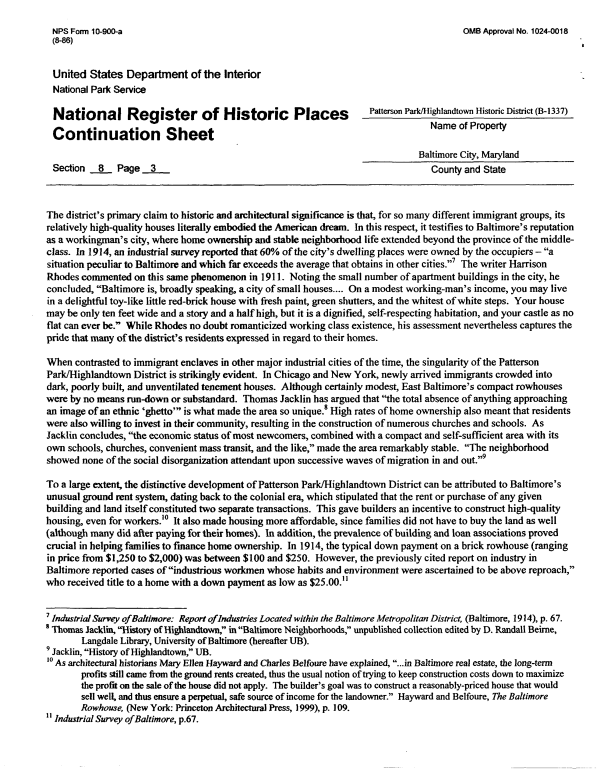 |
||||
|
DEPARTMENT OF HOUSING AND COMMUNITY DEVELOPMENT, MARYLAND HISTORICAL TRUST (Historic Sites Survey) var.d. MSA SE16-3 Image No: se16-3-0098 Enlarge and print image (97K) |
 |
||||
|
DEPARTMENT OF HOUSING AND COMMUNITY DEVELOPMENT, MARYLAND HISTORICAL TRUST (Historic Sites Survey) var.d. MSA SE16-3 Image No: se16-3-0098 Enlarge and print image (97K) |
| NPS Form 1 0-900-a OMB Approval No. 1 024-001 8 (846) United States Department of the Interior National Park Service Historic District (8- National Register of Historic Places -k ,. ,. f^m * Name of Property Continuation Sheet Baltimore City, Maryland Section 8 Page _3_ County and State The district's primary claim to historic and architectural significance is that, for so many different immigrant groups, its relatively high-quality houses literally embodied the American dream. In this respect, it testifies to Baltimore's reputation as a workingman's city, where home ownership and stable neighborhood life extended beyond the province of the middle-class. In 1914, an industrial survey reported that 60% of the city's dwelling places were owned by the occupiers - "a situation peculiar to Baltimore and which far exceeds the average that obtains in other cities."7 The writer Harrison Rhodes commented on this same phenomenon in 1911. Noting the small number of apartment buildings in the city, he concluded, "Baltimore is, broadly speaking, a city of small houses.... On a modest working-man's income, you may live in a delightful toy-like little red-brick house with fresh paint, green shutters, and the whitest of white steps. Your house may be only ten feet wide and a story and a half high, but it is a dignified, self-respecting habitation, and your castle as no flat can ever be." While Rhodes no doubt romanticized working class existence, his assessment nevertheless captures the pride that many of the district's residents expressed in regard to their homes. When contrasted to immigrant enclaves in other major industrial cities of the time, the singularity of the Patterson Park/Highlandtown District is strikingly evident. In Chicago and New York, newly arrived immigrants crowded into dark, poorly built, and unventilated tenement houses. Although certainly modest, East Baltimore's compact rowhouses were by no means run-down or substandard. Thomas Jacklin has argued that "the total absence of anything approaching an image of an ethnic 'ghetto'" is what made the area so unique.8 High rates of home ownership also meant that residents were also willing to invest in their community, resulting in the construction of numerous churches and schools. As Jacklin concludes, "the economic status of most newcomers, combined with a compact and self-sufficient area with its own schools, churches, convenient mass transit, and the like," made the area remarkably stable. "The neighborhood showed none of the social disorganization attendant upon successive waves of migration in and out."9 To a large extent, the distinctive development of Patterson Park/Highlandtown District can be attributed to Baltimore's unusual ground rent system, dating back to the colonial era, which stipulated that the rent or purchase of any given building and land itself constituted two separate transactions. This gave builders an incentive to construct high-quality housing, even for workers.10 It also made housing more affordable, since families did not have to buy the land as well (although many did after paying for their homes). In addition, the prevalence of building and loan associations proved crucial in helping families to finance home ownership. In 1914, the typical down payment on a brick rowhouse (ranging in price from $1,250 to $2,000) was between $100 and $250. However, the previously cited report on industry in Baltimore reported cases of "industrious workmen whose habits and environment were ascertained to be above reproach," who received title to a home with a down payment as low as $25.00." 7 Industrial Survey of Baltimore: Report of Industries Located within the Baltimore Metropolitan District, (Baltimore, 1914), p. 67. 8 Thomas Jacklin, "History of Highlandtown," in "Baltimore Neighborhoods," unpublished collection edited by D. Randall Beime, Langdale Library, University of Baltimore (hereafter UB). 9 Jacklin, "History of Highlandtown," UB. 10 As architectural historians Mary Ellen Hayward and Charles Belfoure have explained, "...in Baltimore real estate, the long-term profits still came from the ground rents created, thus the usual notion of trying to keep construction costs down to maximize the profit on the sale of the house did not apply. The builder's goal was to construct a reasonably-priced house that would sell well, and thus ensure a perpetual, safe source of income for the landowner." Hayward and Belfoure, The Baltimore Rowhouse, (New York: Princeton Architectural Press, 1999), p. 109. 11 Industrial Survey of Baltimore, p.67. |